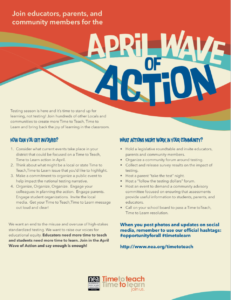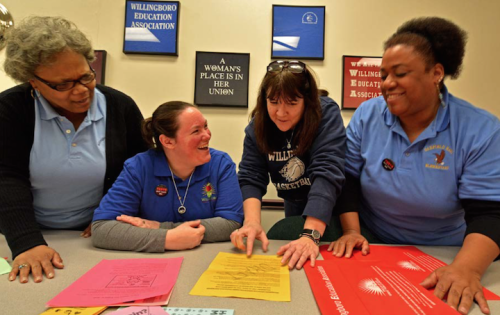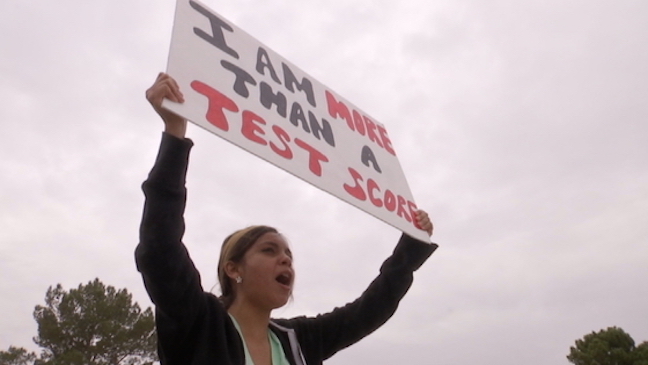Let teachers teach!
Across the country, NEA members and parents are sending the same message to legislators and policy makers: Too much classroom time is caught up in testing, testing, testing, testing, and more testing!
Not enough is spent on learning.
But educators, parents and community members across the country will be shouting "Enough is enough!" during the April Wave of Action. April is testing season and NEA is urging everyone to stand up for learning by organizing public events and engaging local media to get the message out. (Find an event happening near you.)
Luckily, educators haven't waited for April to make their voice heard. Calling for an end to overtesting In Osceola County, Fla., fired-up teachers and education support professionals convinced school board members to work with them to stop the madness in Tallahassee. In New Jersey, a parent recently read aloud to school board members the “NEA Time to Learn, Time to Teach” resolution, and in Washington State, New Hampshire, Missouri, and elsewhere, coalitions of NEA members, parents, students and community members also are rallying for more time for learning.
 Download the Wave of Action flyer and learn how to get involved
Download the Wave of Action flyer and learn how to get involved
“Parents don’t want their children to be treated with a one-size-fits-all education approach. And educators know that students are more than a test score, so let educators teach,” said NEA President Lily Eskelsen García to federal lawmakers, who are rewriting the Elementary and Secondary Education Act (ESEA) this year.
Since 2001, when the sixth reauthorization of ESEA, more commonly known as “No Child Left Behind,” kicked off the nation’s desperate embrace of high-stakes standardized testing, the number of federally mandated standardized tests for K-12 students has more than doubled from six to 17. Add in state and locally required tests, and the numbers soar to levels that can cripple learning.
In Pittsburgh, fourth-graders will sit down for a whopping 33 state or district-required standardized tests this year, or just shy of one per week, according to the Pittsburgh Post-Gazette. In Chicago, even kindergartners must take no fewer than 14. “How do tests breed more tests?” asks FairTest’s Monty Neill. Meanwhile, all of these tests require preparation, pre- and post-testing, data entry, training, and more. When Tennessee teacher Melinda Reese marked instructional days on her school calendar, only ten days were dedicated to actually teaching.
“My teachers are frustrated—I’m losing 20 to 30 at every board meeting from retirements or resignations—because all they do is test, test, test,” says Apryle Jackson, president of the Osceola Education Association.
Over-testing is as ubiquitous as cold germs in American classrooms—but the consequences are even more sickening. In a recent NEA survey, three out of four teachers reported moderate to extreme pressure to improve scores. Forty-two percent said the emphasis had a negative impact on their classroom—and 45 percent said they have considered leaving the profession.
According to the Brookings Institution, the U.S. spent more than $1.7 billion on testing in 2012. Seems the testing mega-industry is the only beneficiary of high-stakes testing insanity.
Misuse of test scores is also rampant. In Florida, for example, at least 40 percent of teachers’ evaluations (and thus their pay) must be based on a bizarre value-added model that incorporates test scores from students they’ve never taught or subjects they don’t teach. Farther north, the Tennessee Education Association has filed two lawsuits against the state, challenging its use of a similar value-added system: The lead plaintiff, an 8th-grade science teacher, was denied a pay raise after his value-added score was based on the test scores of only 22 of his 142 students.
Worst of all, testing infiltrates instruction, making it harder than ever for teachers to teach a love of learning or indulge students’ curiosity. If it’s not tested, it’s not taught — and that often includes art, music, and physical education. Creativity is shot—along with teachers’ professionalism. In Osceola, says Jackson, “all teachers are expected to teach the same thing on the same day, and whether students have mastered it or not, they test and go on.”
“This is my eighth year of teaching, and I’ve never before felt this frustrated and not believing in what I’m doing,” says Christy Brittain, an Osceola third-grade teacher, whose stressed-out students face retention if they don’t pass the state’s new never-before-given third-grade reading test. “I don’t think I should be testing this much, and I feel like it’s right for the kids.”
Standing up for Teaching
Teachers and parents have had enough. Instead of sharpening more test-taking pencils, they’re honing their arguments and building coalitions to fight for more time for teaching and learning. In Willingboro, N.J., after many months of community meetings and showings of the documentary film, “Standardized,” a parent recently introduced NEA’s “Time to Teach, Time to Learn” resolution to school board members. (Check out NEA’s eight-step guide to passing the resolution.) That resolution calls on boards to support local, authentic assessments, and state systems that rely on multiple measures of student performance.
 Willingboro, N.J., educators and allies, including local union president Vicki Benedict, second from right, strategize before a school board meeting.
Willingboro, N.J., educators and allies, including local union president Vicki Benedict, second from right, strategize before a school board meeting.
Meanwhile, in Osceola, first-grade Barbara Mundinger told school board members in November: “I have the best job in the world, and I used to love it! But I don’t have the time anymore to talk with each child, to find out what clicks with them, to build relationships so that I can guide them in learning. I love the kids, but I can’t do the best for them. We need to have more time for the kids.”
School board members agreed: “A pig doesn’t get heavier by weighing it more often,” said one. “You guys, you work hard, I know you love kids, and I know you want to do what’s best for kids …we all need to get into this.”
“The tests don’t teach,” says Willingboro Education Association President and school secretary Vicki Benedict. “We’ve turned educating kids into testing kids, and it’s bad for kids, it’s bad for parents, and it’s bad for teachers.”
Benedict isn’t the only one who thinks so. Across the country, tens of thousands of NEA members are working for testing reform through coalitions that include parents and students.
Last year, 30,000 Oklahoma Education Association (OEA) members, parents and students flooded the streets around the state capitol, demanding state lawmakers increase funding and decrease the barrage of standardized tests. “We must turn our classrooms back over to our teachers,” said Jeffrey Corbett, president of the Oklahoma Parent Teacher Association. This year, Oklahoma educators are sending thousands of postcards to lawmakers, and plan to introduce the “Time to Learn . . .” resolution in dozens of school districts. (For more, see OEA’s “Stand Up Against High Stakes Testing” website.)
Likewise, in Colorado, thousands of educators and parents are connecting on the Colorado Education Association’s (CEA) Facebook page, “Free Our Teachers, Value Our Schools,” and through community meetings and polls, which have shown that two out of three Colorado voters want less testing.
On March 25, parents, students, educators and community members rallied in Denver against excessive standardized testing.
“Of all the things we teach our kids, the most important is the love of learning," CEA President Kerrie Dallman told the crowd. "No bubble test can ever measure that. What educators need now is the time to teach so that students have the time to learn. Too much time spent on standardized testing takes up too much valuable time spent on learning.”
 Colorado Education Association President Kerrie Dallman speaks up for more learning, less testing at a Denver rally on March 25.
Colorado Education Association President Kerrie Dallman speaks up for more learning, less testing at a Denver rally on March 25.
On one side of the country, more than 150 Washington State teachers, education support professionals, parents, and students rallied in March to oppose high-stakes testing and support the state’s “opt-out” movement. On the other side of the nation, the Maryland State Education Association (MSEA) in December asked state officials to suspend its new Kindergarten Readiness Assessment, which requires kindergarten teachers to test each of their students, one on one, during the first weeks of school.
More than half of kindergarten teachers told MSEA in a survey that each test took at least one hour and 25 minutes to administer, and 91 percent said the findings would not help their instruction.
“Kindergarten teachers already collect data—how many letters do our students know, how many sounds do they know, how high can they count. ...” Maryland kindergarten teacher Olivia Granta told NEA Today in January. “We may not be mandated to know these things, but we have to know them because we have to instruct them.”
These efforts already are benefiting students and educators: Last year, Missouri educators and parents crushed a constitutional amendment that would have tied almost everything about a teacher’s job to test scores. The proposal, which had the backing of a deep-pocketed right-wing conservative, lost by a vote of 3 to 1 and failed to carry a single county. “Missourians value their local schools and want extremists to keep their hands off,” said Missouri National Education Association President Charles E. Smith following the vote. Educators’ persistent advocacy also reduced the number of tests.
And, in St. Paul, Minnesota, where “most parents and teachers were frustrated by the amount of instructional time lost daily to testing, especially test preparation,” says Nick Faber the union’s vice president, the St. Paul Federation of Teachers won a contractual commitment to reduce the number of tests.
“We’re already winning,” says Willingboro’s Benedict, “because people are asking questions about what we’re doing to our kids.”
Video: Congress is Talking About Testing








